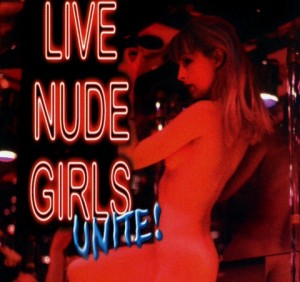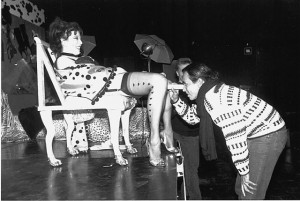
Live Nude Girls Unite! is a documentary about the efforts that went into creating a union for sex workers at the Seattle strip club The Lusty Lady. Taking place from 1996-1997, it was released in 2000. This documentary argues that sex work is legitimate labor and that sex workers are insufficiently protected by current labor laws. It also posits that sex work isn’t an inherently antifeminist practice. The structural practices that encompass sex work are just, in most cases, anti-woman (as well as racist and classist.) The abuses that they protest include: discriminatory hiring based on race, not doing enough to protect the dancers’ privacy, and under paying them. It’s also about the relationship one of the directors – Julia Query – has with her mother. Query’s mother, Joyce Wallace, is a prominent doctor and activist for sex workers in New York. For decades, she drove around in a van handing out condoms and performing STD tests on NYC streetwalkers. She raised her daughter a feminist. Still, Query has trouble telling her that she’s a stripper. When Wallace does learn, she reacts badly. Despite her activism, she believes that sex work is demeaning to women. This reveals the stigma that sex workers have to combat even amongst their most natural-seeming allies. After intense negotiation, they reach a compromise with The Lusty Lady, turning it into the only unionized strip club in the United States at that time.
Whether sex work can be feminist has been a contentious issue within the movement since the 1970s. Known as the Feminist Sex Wars, the discussion is divided into two camps – the anti-pornography feminists and pro-sex feminists. The point of contention is whether sex work is inherently based on the exploitation of women. Anti-pornography activists point to the structural abuse and misogyny inherent in most sex industries, while pro-sex feminists argue that this blanket condemnation overlooks the agency of individual women in the sex industry. In this film, Wallace is anti-pornography while Query is pro-sex. The film itself is pro-sex. Live Nude Girls Unite! contains testimonials from dancers who identify with feminists and describe their sex work as empowering. While the film criticizes the exploitative institutions that house sex work, the dancers/protestors are framed as admirable in seeking their own worker- and performer-centric establishment. The film’s perspective on anti-pornography feminists (via its depiction of Wallace) is disappointment that they can’t overcome their prejudices regarding sex work to engage with a younger generation of activists.
Live Nude Girls Unite! also depicts an intersection between feminism and the labor movement. According to Wikipedia, the labor movement is, “the collective organization of working people developed to represent and campaign for better working conditions and treatment from their employers and, by the implementation of labour and employment laws, their governments.” In the documentary, dancers at the Lusty Lady unionize in order to combat low wages, discriminatory hiring practices, and insufficient protection from abusive clients. Feminist labor movements face the added challenge that women’s labor is often undervalued. For example, mainstream economics has historically ignored unpaid labor performed by women, such as domestic or caregiving work. Sex work, while paying, is deeply stigmatized. Live Nude Girls Unite! documents the ways in which employers try to downplay sex work as labor. The Lusty Lady’s owners were particularly adamant about retaining a description of the performance as “fun.” Alongside downplaying the job’s physical and emotional toil, this would have helped them frame dancing as lower-paying and less regulated “part time” work in court.
At the end of the film, the workers win many of their proposed gains and unionize. In 2003, the Lusty Lady become a worker’s cooperative. It was an important experiment in a sex work establishment owned by the workers themselves. The Lusty Lady closed its doors in 2013 due to declining profits and failed rent negotiations. Julia Query went on to become an author and public speaker. Vicky Funari continues to make documentaries about women’s labor, such as Maquilopolis. (2006)
Links
Interview with Joyce Wallace about her work combatting AIDS in sex workers during the 1980s.
Vicky Funari’s filmography.
Retrospective on the Lusty Lady as of its closing in 2013.
Overview of the Feminist Sex Wars.
Books on The Lusty Lady.
Eaves, Elisabeth. Bare on Women, Dancing, Sex, and Power. New York: Alfred A. Knopf, 2002. Print.
Langley, Erika. The Lusty Lady. Zürich: Scalo, 1997. Print.
Other films by Vicky Funari on tripod.
Paulina. Dir. Vicky Funari. First Run/Icarus Films, 1997. Videocassette.
Maquilapolis (city of Factories). Dir. Vicky Funari. California Newsreel, 2006. DVD.



